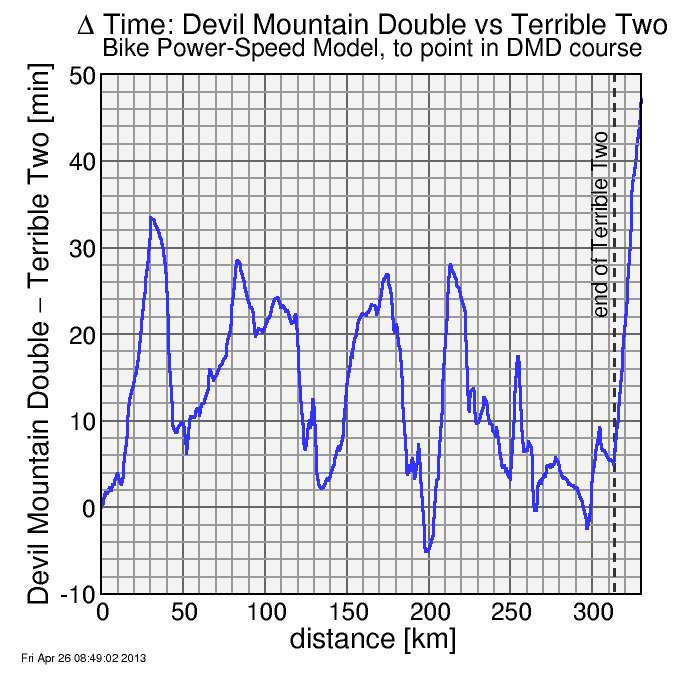Modeling time difference between Devil Mountain Double and Terrible Two
I previously described a heuristic but fairly comprehensive bike power-speed model. This was based on trying to model speed directly from course features, rather than going through power, since riders typically don't ride at a constant power, although that represents a physiological constraint. The model assumes riders have a given cruising speed on flat roads (I assumed 30 kph), a theoretical maximum rate of vertical ascent (I assumed 1300 m/hr), and a safety-limited rate of descending (I assumed 14 m/sec = 50.4 kph based on conditions on these courses; perhaps this was slightly low). I assumed a rate of fatigue of 0.5%/hour, which affects climbing rate (directly) and speed on the flats (1/2 as much). The model further assumes riders lose distance versus time when they turn: 40 meters per radian of cornering at max descending speed, much less when cornering slower (proportional to speed squared). I have compared this model to actual rider data and it seems to match fairly well.
With these assumption, I get the following ride times for Devil Mountain Double versus Terrible Two:
| Terrible Two: | 313 km in 13 hrs 15 min 28 sec |
| Devil Mountain Double: | 330 km in 14 hrs 2 min 36 sec |
So Terrible Two is definitely faster, as promised by Quack Cyclists. The difference for this sort of pace, however, is 47 minutes, not the two hours warned by Quack Cyclists, although their focus group for this warning is riders at threat for not making the course cut-off, and for longer times the gap will be larger, not necessarily in linear proportion.
Devil Mountain Double falls almost 40 seconds behind by the Diablo summit, then gains some back on the descent, but then loses time out to 100 km. Terrible Two loses time here with the tough Geysers climb. DMD falls behind again, but Terrible Two does the hard section of Skaggs Springs Road, and DMD actually pulls ahead by up to 7 minutes. But T2 has a relatively fast run on the coast (the model isn't considering the wind here, which is typically a tail wind, making Terrible Two even faster here) while Devil Mountain Double deals out the challenging climbs of Mines Road and Sierra Road. By 297 km, DMD is ahead again, falling only slightly behind by the time Terrible Two completes at 313 km. But there's still 17 km left in DMD at this point, so DMD end up being 47 minutes slower.
Of course many factors affect this result: wind, heat, cold, darkness (although 14 hours is fast enough to finish DMD in light). An additional factor favoring T2 is more opportunity for pacelining, as was pointed out to me by John Murphy. The basic conclusion, though, is differences in terrain are a relatively small factor: DMD takes longer because it is longer.


Comments